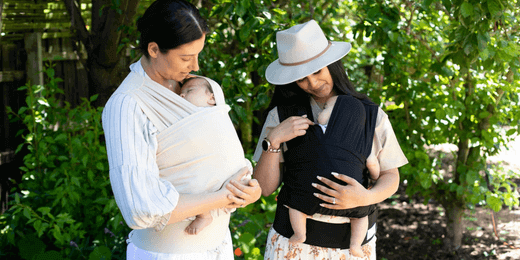Happy International Breastfeeding Week!
This is a week to celebrate the life giving gift of breastfeeding and to acknowledge the sheer selflessness of the women who choose to breastfeed. We also champion those women who choose to supplement or formula feed for a variety of reasons from personal choice to medical advice. Any, and all of the ways we feed our babies is valid, celebrated and acknowledged.
What a time it is to be alive, when this contribution of mothers, to our children and the earth is recognised publicly around the world.
For many new mothers, breastfeeding comes naturally and others less so, it is a relationship that has it's triumphs and its challenges.
With this in mind, we thought the best way for BabyDink to be of service to our community is to bring in the expert.
Meet Jessica Kahan (RM, IBCLC, NDC). Mother of two. Midwife, Lactation and Breastfeeding Expert.
Read, invaluable resource for breastfeeding mums.

Jess has built a business that aims to bring together a philosophy of supportive, considered and individualised services for women and families on the breastfeeding journey.
She has drawn on nearly a decade of experience in the perinatal and post natal space to bring together this comprehensive resource for those wishing to breastfeed - in this Two-Part Series you will be guided through the most commonly asked questions and challenges women face.
Read on to hear, in her own words - the important message Jess has for breastfeeding mothers...
Breastfeeding can be incredibly challenging for many mothers if they do not have access to adequate lactation services. An International Board Certified Lactation Consultant (IBCLC) is a trained health professional who can help you to improve your breastfeeding journey and make feeding enjoyable for you and your baby.'
An IBCLC will mostly have another health qualification and could be a nurse, a midwife, a GP or even a physiotherapist who goes on to do further study in breastfeeding science and management. We are health professionals who are passionate about improving and protecting breastfeeding rates.
As a privately practicing IBCLC, I see women in my clinic daily to assist them with breastfeeding challenges from the birth of their baby, right through to weaning. Today I am going to chat through the five most common breastfeeding concerns I see at my clinic.
Nipple Pain
Nipple pain is hands down the most common presentation in my clinic. At least 50% of the women who visit me are troubled by significant nipple pain. The good news is that most of these women leave my clinic breastfeeding pain free. For some there is significant existing nipple damage that may take a few days to heal. However, with the techniques learnt they can begin their journey of pain free breastfeeding.
Let me be clear, nipple pain is NOT a normal part of breastfeeding. It is not something we need to wait out, toughen up or put up with. Nipple pain is our very clever body telling us to make adjustments to our baby’s position. Pain tells us that our baby is not attached well and we need to change something. I have breastfed two children and I have never had nipple damage. So please, if someone is teaching you to feed your baby and they tell you your latch “looks good” but it hurts you, get a second opinion. Your latch needs to feel right!
So how do we remove pain and perfect our latch? Well, every mum and baby are different; our anatomy differs to other women, and the way we and our babies fit together as we feed differs from woman to woman and even from breast to breast in the same woman. Most importantly, we need to feed our baby at the height the breast naturally falls to avoid dragging of breast tissue while baby feeds. Tissue drag is one of the most common reasons for nipple pain. It is also the easiest to fix. Our nipples do not point straight out in front of us, mostly they point in a somewhat downward position. So often babies are coming to the breast way too high which holds the breast tissue up while gravity pulls the breast down and out of their mouth, making maintaining a deep latch very hard. Thanks to breastfeeding pillows many women are battling through pain because their baby is simply too high on their body. Yes, that’s right, your breastfeeding pillow may be causing you significant pain!
There are many other reasons why nipple pain can exist and lots of ways to adjust your baby to improve it. So please, if you are having trouble with sore, cracked and bleeding nipples, contact your local IBCLC. Do not accept pain as part of your journey.
Newborn falls asleep feeding but when put down, is suddenly hungry again
Is this you? Do you feel like your baby can be perfectly asleep, so peaceful and calm after a feed? Those beautiful milk drunk breathes fill your heart as your baby relaxes safely on your chest. You think now is the time to put them down, but oops, they are suddenly awake and crying. Don’t stress, this isn’t just you.
Did anyone explain to you about the “Rest and Digest period”? This is a very common and incredibly important part of a breastfeed. In the early weeks and months of breastfeeding, your baby will often need a 10-15-minute rest and even sleep between breasts. For example, they may have a 20-30- minute breastfeed on the right, fall asleep, detach from the breast and sleep for 10 minutes. All of a sudden, they rouse, start routing and searching for food. This is when they are ready to take the second side.
If we actively wake them, undress them, blow on them with the intention of waking them for the second side before they are ready, it can cause issues like colic, vomiting, sleepiness at the breast or breast refusal. Most concerningly it often makes mums feel they do not have enough milk. Well, I am here to tell you that this not a sign of low milk supply.
The Rest and Digest period is very normal for a young baby. As they grow, they will be able to take a whole feed with no mid-meal rest, but those weeks are later. Your baby isn’t broken, your supply is not low. It’s just a completely normal part of breastfeeding. One way to check is by lifting their arm at the end of a feed. If they still have some tone and strength in their arm, you can be sure they will be ready for the rest of their feed very soon. If the arm is flaccid and falls straight back down, they might be ready for their sleep. You can try to put them down if you like or enjoy a beautiful cuddle moment while you rest and recover also.
Stay tuned for Part 2 - Delivered to your Inbox on Sunday...We hope you've found this helpful.
If you or someone you know is having trouble breastfeeding their baby, please reach out to your local IBCLC.
If you are in Australia or NZ you can find out more here







Leave a comment (all fields required)